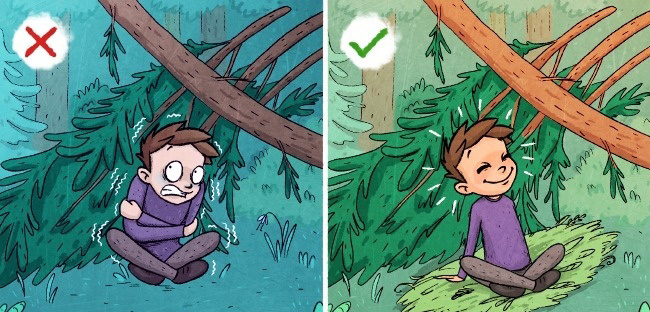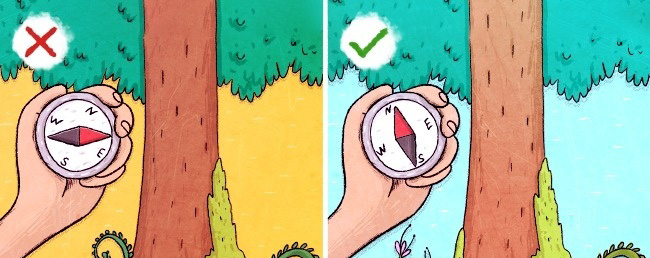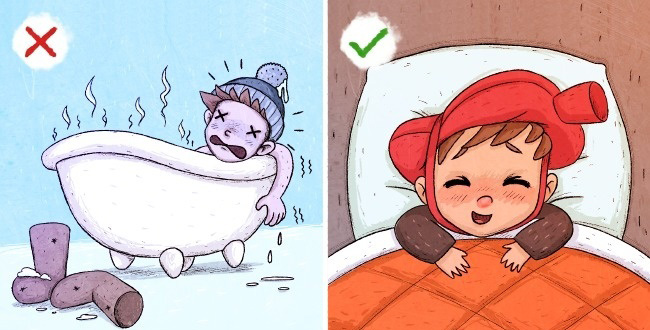There are many rules that explain how to behave in emergency situations. But are they all really that effective? We found that some of these survival tips are actually myths that are not only useless but also potentially dangerous.
Biggest Survival Myths
First Aid For A Snake Bite

Don’t: If you’re bitten by a snake you need to suck the poison out.
Do: The most important thing is to get to the hospital as quickly as possible.
Snake venom enters the bloodstream extremely quickly and does not accumulate at the bitten area. Therefore, trying to suck it out is ineffective. Also, putting your mouth over the bite can cause poison in your mouth and esophagus.
The best way for a bite victim to prevent the poison from moving quickly through the bloodstream is to stay calm, keep the wound below heart level, drink plenty of fluids, and of course try to get to the hospital as soon as possible.
What To Do If You Get Lost In The Forest
Don’t: If you get lost in the forest you need to find a source of food immediately.
Do: Your first priority is to find a source of drinkable water and build a shelter.
You must have heard that the first thing you should do if you get lost in the wilderness is to find food. This is not entirely true.
A healthy person can live without food for a long period of time: up to 6 weeks. But finding a water source and building a shelter where you can hide from extreme weather are your top priorities.
How To Build The Perfect Shelter

Don’t: A lean-to is a great shelter from bad weather.
Do: A lean-to might help protect you from cold only when you build up a layer to insulate you from the cool ground.
Before starting a suitable shelter, you should assess the environment and weather conditions. You need shelter to protect yourself from the wind, rain, or scorching sun.
But just building lean is not enough. Cold soil literally absorbs heat from you at night, unless you build a layer between your body and the ground.
How to Find Water In The Desert
Don’t: The fluid in a cactus can save you from dying of thirst.
Do: Only specific types of cacti provide relatively safe drinking water.
There is only one type of barrel cactus that contains drinking water. You can also get moisture from Opuntia.
But most of the time, cacti are poisonous. Drinking the liquid inside them will make you sick, vomit a precious liquid, and leave you more dehydrated.
How To Survive A Bear Encounter
Don’t: If you encounter a bear on the trail, play dead.
Do: If you see a bear, stop and back away slowly.
Bears don’t want to attack, much less eat you. Therefore, in most cases, you only need to back up slowly, keeping an eye on the bear. Keep your distance. This will show the bear that you have no claim to its territory.
How To Know Which Plants Are Safe To Eat And Which Are Toxic

Don’t: If an animal eats something, you can eat it too.
Do: You can eat only those berries and mushrooms you can identify as edible species without a doubt.
In fact, some fruits and mushrooms that are deadly to humans are not poisonous to many animals and birds.
Therefore, the only way to distinguish an edible from a poisonous plant is to accurately identify the species of each fungus or berry.
How To Find Direction By Tree Moss

Don’t: Moss grows on the north side of a tree.
Do: Moss can grow -on all sides of a beet
Moss can grow on all sides of a tree, depending on environmental conditions. Don’t trust this popular myth when you try to get out of the woods or you will get lost. Here are ways to indicate direction without a compass.
How To Treat Hypothermia

Don’t: If a person gets hypothermia, you need to put them into a hot tub.
Do: Warm the person’s core up gradually in order not to cause shock to their body.
Never rub frozen areas, as this can cause further tissue damage. You should also not use hot water or a heating lamp to warm the victim. Such treatment can end up impacting the victim’s body.
Instead, you should gradually warm the person’s core, preferably with blankets and a few bottles of warm water under their armpits.
How To Survive A Shark Attack
Don’t: If a shark attacks you, punch it in the nose.
Do: The eyes and gills of the shark are much more vulnerable.
You must have heard that you must hit a shark in the nose to survive the attack. Even if this is true, many people do not have the strength to do it, especially underwater.
In the extremely rare case of a prolonged negative encounter, try placing a solid object between you and the animal (for example, a diving mask or a swimming board). If nothing is at hand, the best way to keep a shark away is to scratch its eyes or gills.
Based on materials from iflscience, mixstuff


